
Archives

Archive for September, 2010 | |||||||||||||||||||||||||||||||||||||||||||||||||||||||||||||||||||||||||||||
MasterbuildersPosted on September 1, 2010 | Click for larger images
| Throughout the years we have been graced with a pheonomenal assortment of highly skilled luthiers, spanning Hamer's various eras and guitar styles. This didn't happen by chance. We sought out the best and most talented individuals and then began a relentless undertaking of cultivating them with Hamer's spirit and luthiery techniques. The result is that over our 30+ year history we have been able to instill an unsurpassed commitment to quality in our team to build the Ultimate guitars. These are the people who create our guitars; these are our Masterbuilders. Execution at this level of luthiery is no easy task. Very few can do it. Many question which era of Hamers were the best. Much hinges on the style of guitar you are drawn to. Regarding build quality, we feel that we are at our pinnacle. However, we would have said the same thing in the past and probably will do so in the future. That's because we are never satisfied; we always want to improve. At any point in time our guitars are generally the best that they have ever been. This Watson may be from another era but it was definitely created today. The neck cavitiy is chiseled open for a seamless neck joint. Add a blended heel to the equation and you have unsurpassed access at the highest frets. Speaking of frets, we've reviewed sanding of both our woods and finishes, we'd like now to review how we sand, or level, our frets. The process is not unlike sanding wood or a finish in that we use progressively finer grits. The first step in a Hamer fret job is to straighten the neck. We then take a custom built aluminum honing block with 220 grit cloth and just touch the frets to determine whether they are all level. Then, starting at the nut, we lightly sand the frets with the 220 cloth on the honing block so that each fret is ever so slightly lower than the fret before it. Using a diamond 320 crowning file we then remove any flat spots on the crown of the bead.  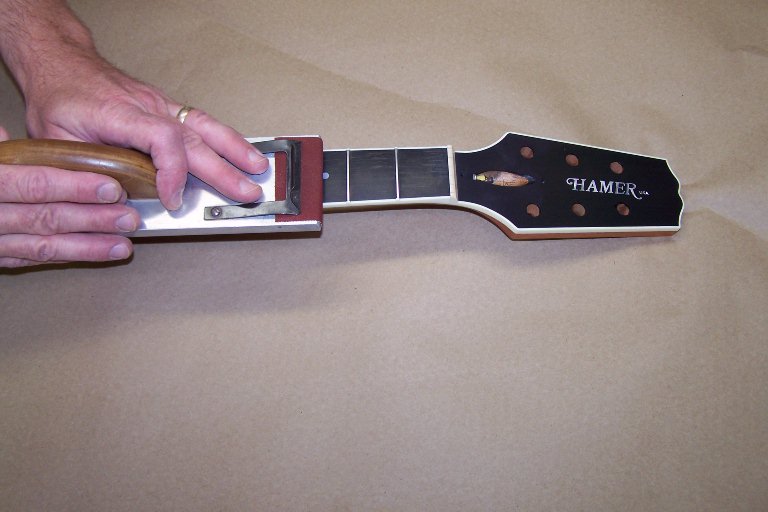 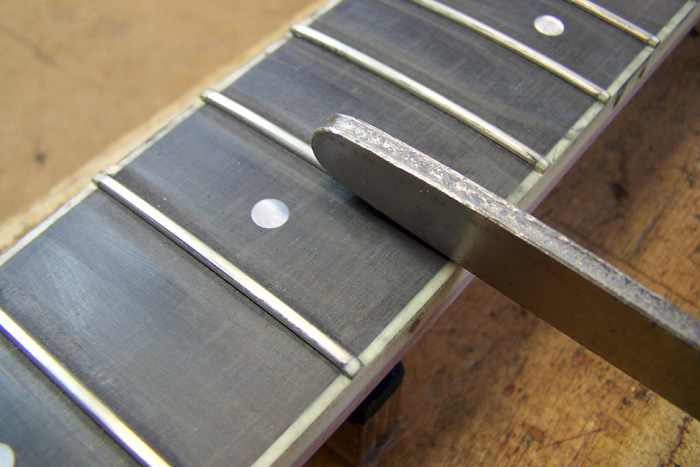
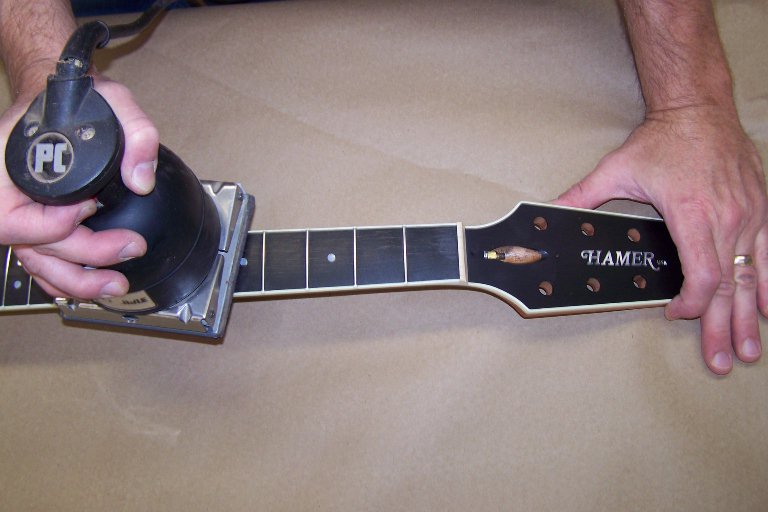 We then go over the frets with a jitterbug sander using 240MX paper. 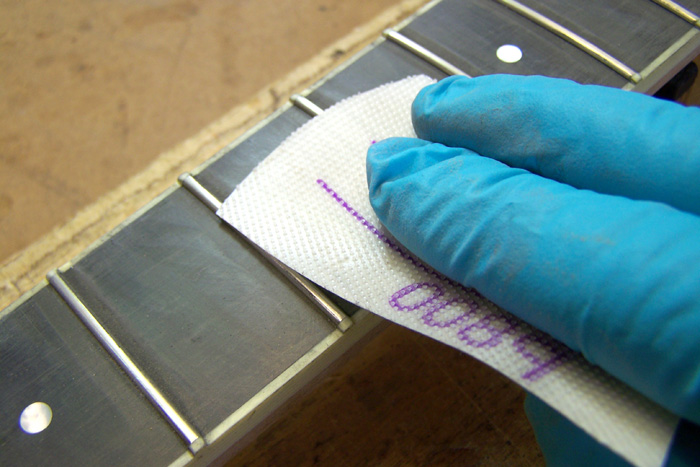 Next, we hand sand with 800 grit paper. 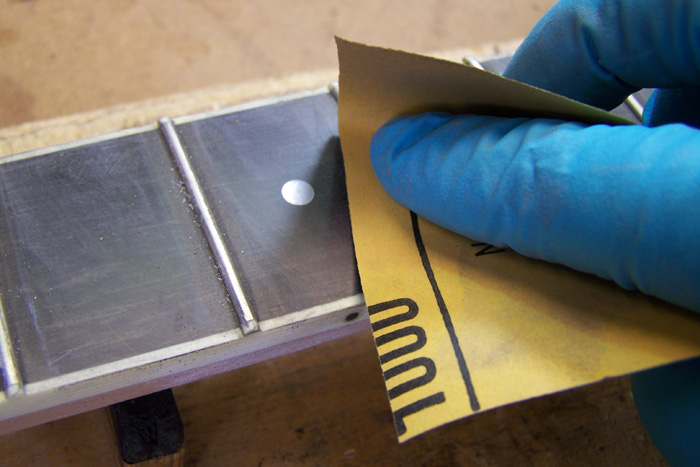 This is followed by another hand sanding, this time with 1000 grit sandpaper, a very fine grit with which to sand metal. 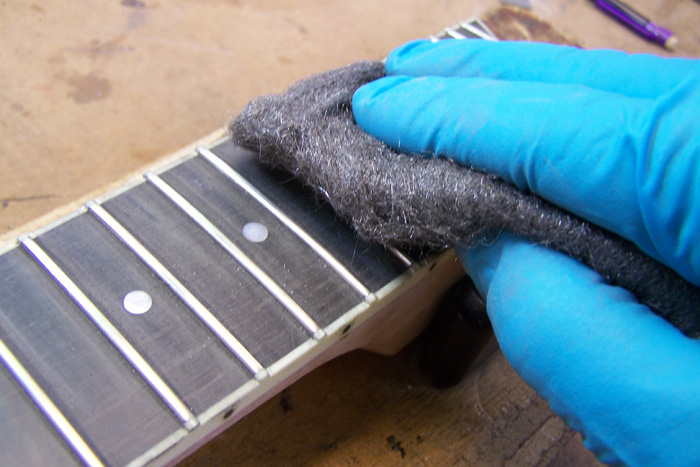 Finally, we polish the frets with 0000 steel wool. There's a very high skill level required to effect this process. The trick is to take off only the bare minimum of fret material with each progressive sanding. This is how our luthiers create the silky feel that is a Hamer fret job. 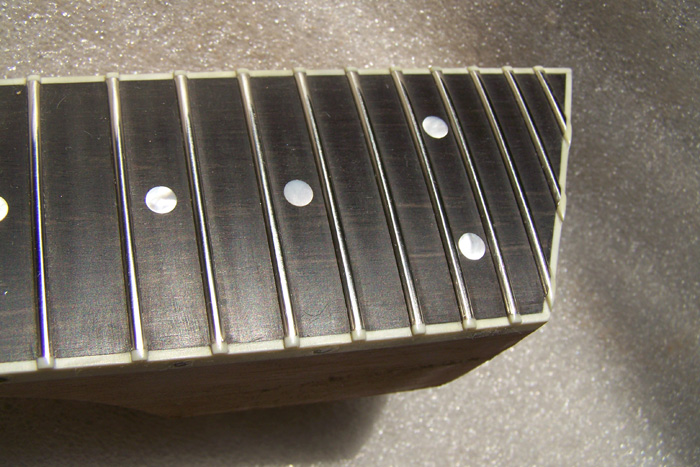 Finally the neck and the body are bonded together. This is luthiery. This is masterbuilding. 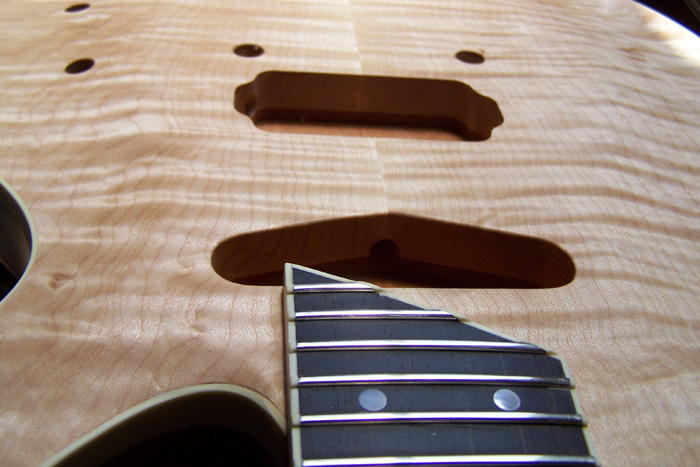  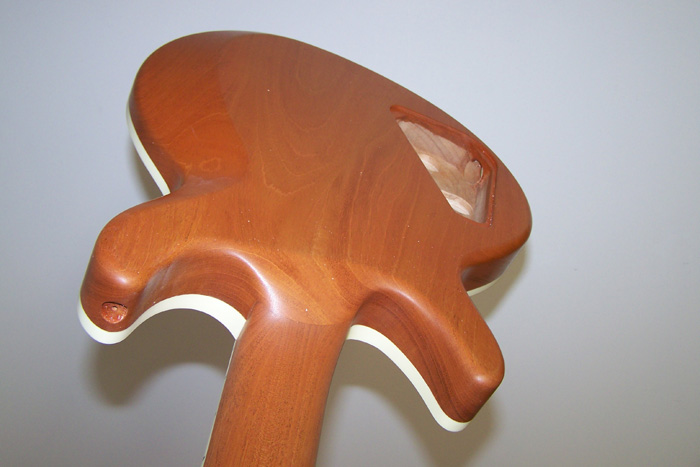 MaroonedPosted on September 10, 2010
| Several weeks ago our friend Mike Buffa called, asking if we would like to attend the Maroon 5 concert at the Mohegan Sun Casino here in Connecticut. Prior to working with lead guitarist James Valentine of Maroon 5, Mike worked first with Jane's Addiction and later with Nuno Bettencourt. We had heard that James Valentine had a connection with Hamer in the past but we didn't understand what that connection was. It seemed natural to try to determine the history. The rich history of Hamer guitars and the people who have played such an integral part in making that history does not cease to astound us. The support has come from a wide range of people. It starts with all of those at the shop itself, from the original basement workshop in Wilmette, Illinois to our shop in Palatine continuing to our much expanded shop in Arlington Heights and finally on to our current home in New Hartford, Connecticut. Most are aware of the principles at Hamer Guitars, fewer know the names of the people who built so many of the guitars, from our original builders such as John Montgomery continuing through to those who we feature today. Throughout, we have built on what we learned from those before us. That is why our build quality has only continued to improve. Our history has of course also been very much impacted by the musicians who have played our guitars over the years. These musicians have come from all styles and genres of music. Some are household names, others are not. They all have added something to our history. We may create the guitars in our shop but it is the musicians who bring them to life. The music dealers too have had an influence on Hamer. Our strongest music dealers have generally been those who shared our passion for Hamer Guitars. One such store was Dietze Music in Lincoln, Nebraska. In talking with James Valentine, we learned that his connection with Hamer Guitars dates all the way back to when he taught guitar at Dietze Music. As such, James was surrounded by Hamer enthusiasts and had ample opportunity to play early Hamers. We had discovered his connection and it reached back. Of our current offering, James was immediately drawn to the Talladega. However, he was looking for a humbucking version. We sent both a Talladega and a Talladega Pro for James to try out on the road. As expected, he went for the Talladega Pro. The Talladega Pro that we shipped was finished in Amberburst. James wanted the guitar in black but was concerned that putting a hard rock maple cap on it, like we normally would do on a black guitar to minimize finish sinking, could alter the tone. Therefore, the first step was to select a top. We had three pretty spectacular tops, any one of which would do the trick. We settled on "C". It has has an outrageous flame that we hope will be noticeable from stage. We then milled out a back and set to work bonding the maple top to the mahogany body. Here's a clear shot of the chambering that we do on a Talladega Pro. You'll notice that, unlike a Talladega, the mahogany "island" extends from where the neck cavity will be routed to bridge. We use a paint roller to spread the glue over the mahogany.  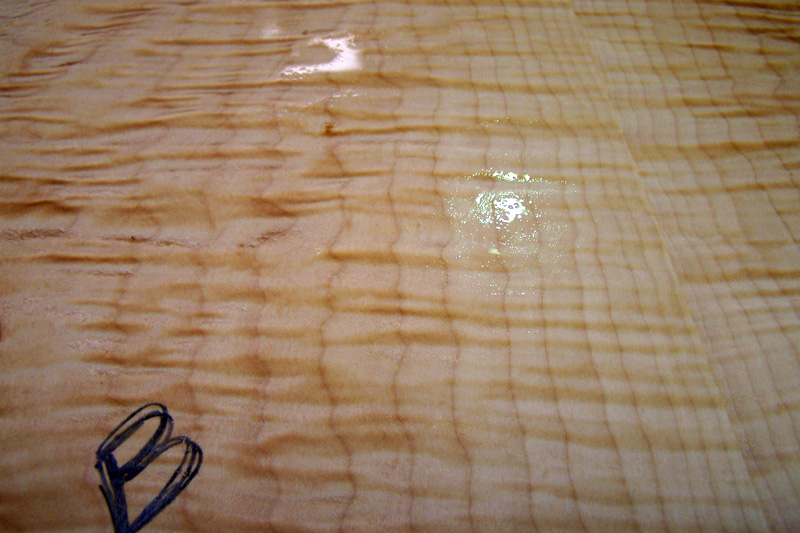 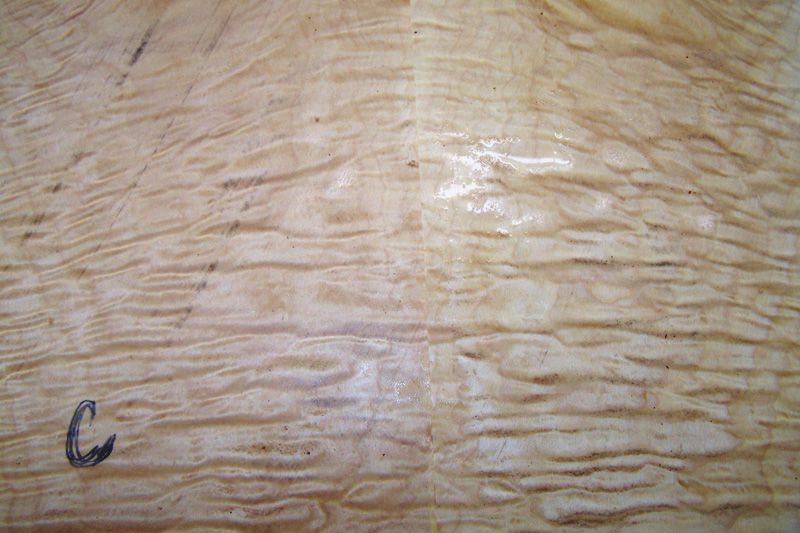 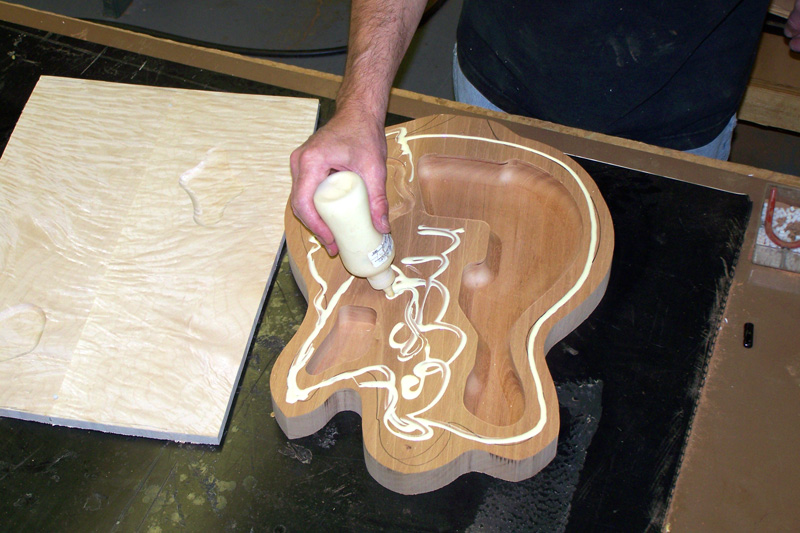  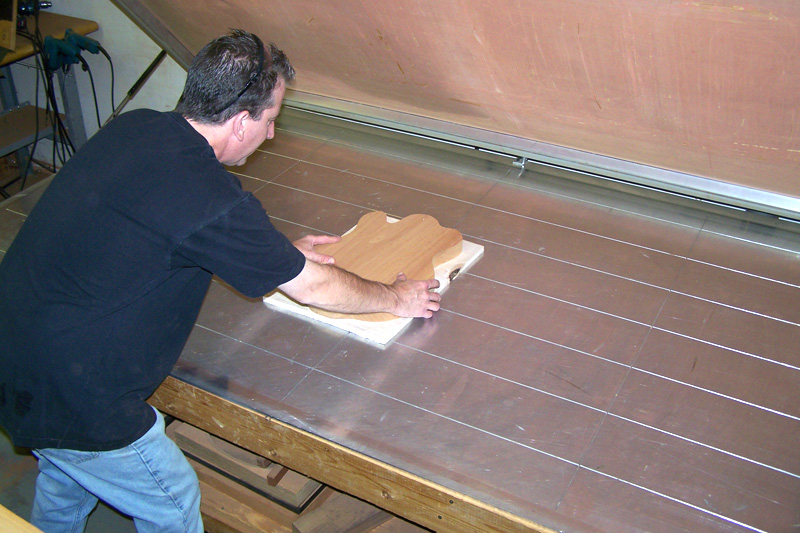 Rather than using clamps to bond the mahogany and maple together, we use a vacuum membrane, appropriately called a Membrano. Here, Dave is loading the Membrano. 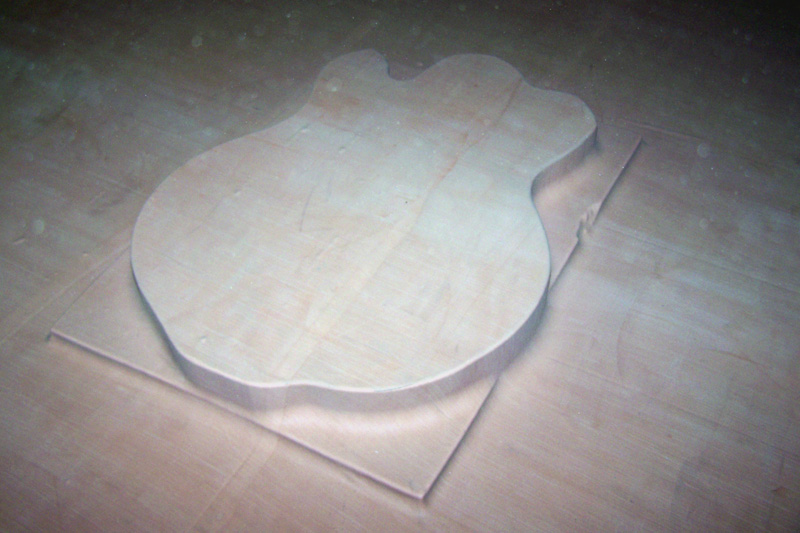 By using vacuum, we get even pressure over the entire surface. This is very visible once the vacuum has been activated and the air evacuated.  After the body has been bonded and bound, we rough cut the arch in the top. Notice how we tape down the body binding so that it won't tear away during the routing process. 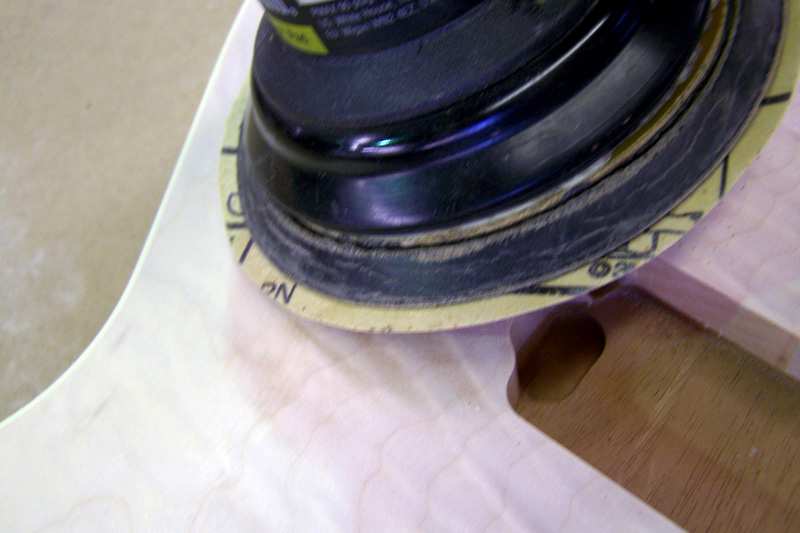 There's still a significant amount of hard carving and sanding that goes into the top. Here we're using an random orbital sander. We start with 80 grit paper, continuing to 120, 180, 220 and finally 320 grit. We pay particularly close attention to the horns. Some guitar companies flap sand their tops. This results in a rounded look. We like to see definiton in the horns. Here we're using a Dynabrade sander to remove the mill marks. After the mill marks are removed, we'll final sand with 220 no fill paper. 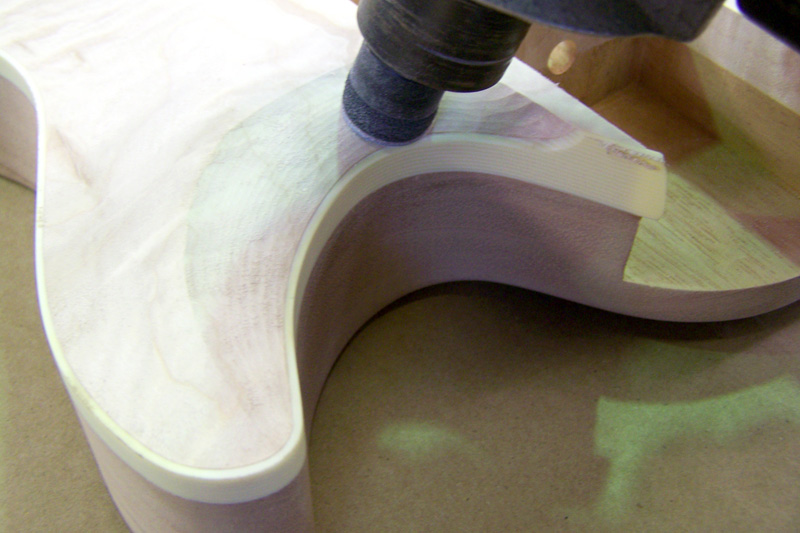  Naturally, the same process applies for the back as well.  Nice.  Hand drilling the strap button hole. 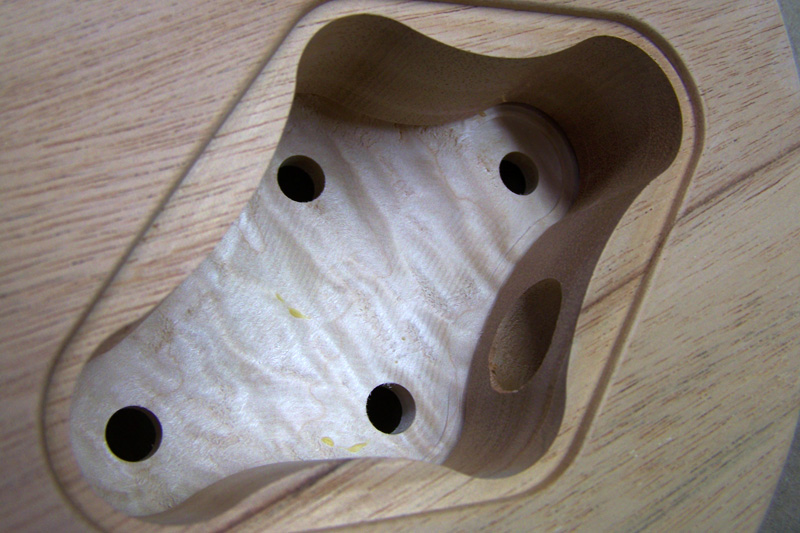 Because we apply shielding paint to our electronics cavities, here's something that you won't see every day on a Hamer, the contrast between the figured maple and the mohagany viewed from the back. 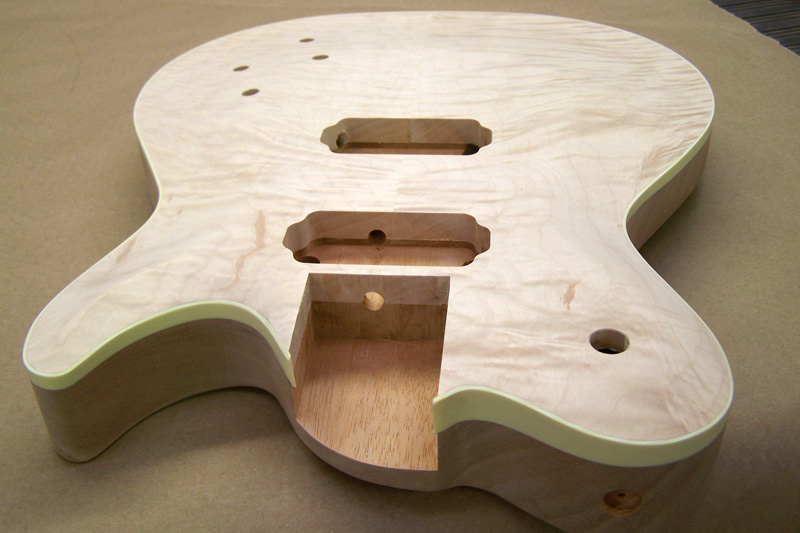 The body is completed. Meanwhile, Tom Maule is pretty far along on the neck. Here he's using a heat gun to make the celluloid binding more pliable to insure a snug fit to the peghead. As celluloid is higly flammable, Tom has to be careful how much he heats up the binding material. 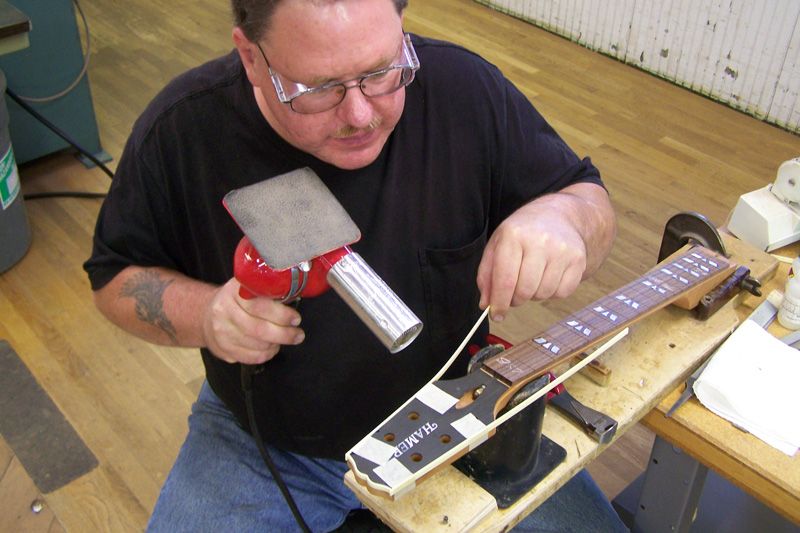 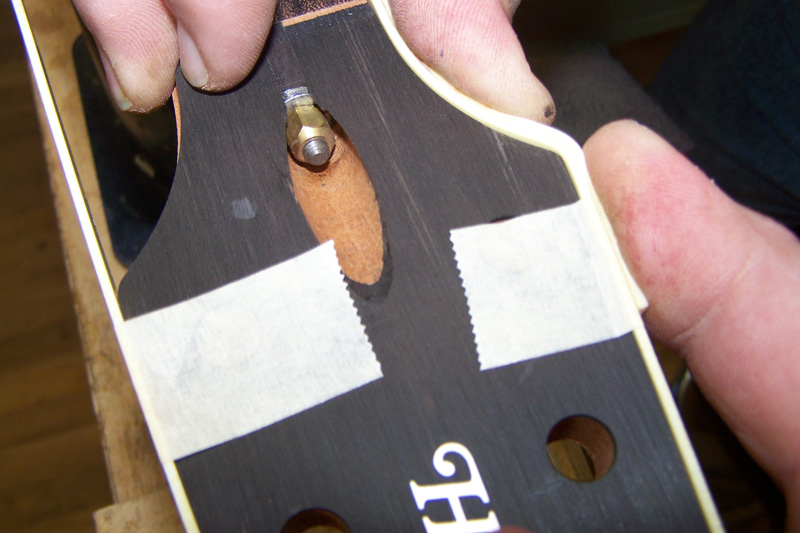 Tom starts with several pieces of tape to hold the binding in place. 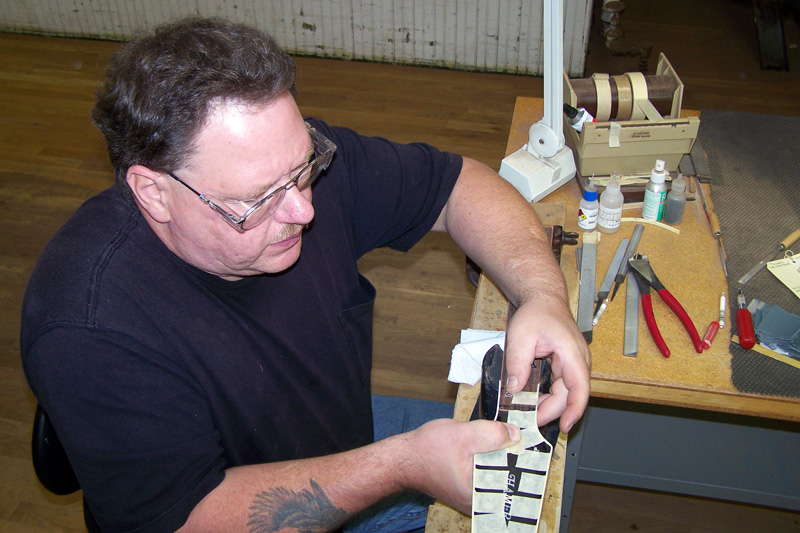 By the time he's done, the entire perimeter of the binding is securely taped in place. 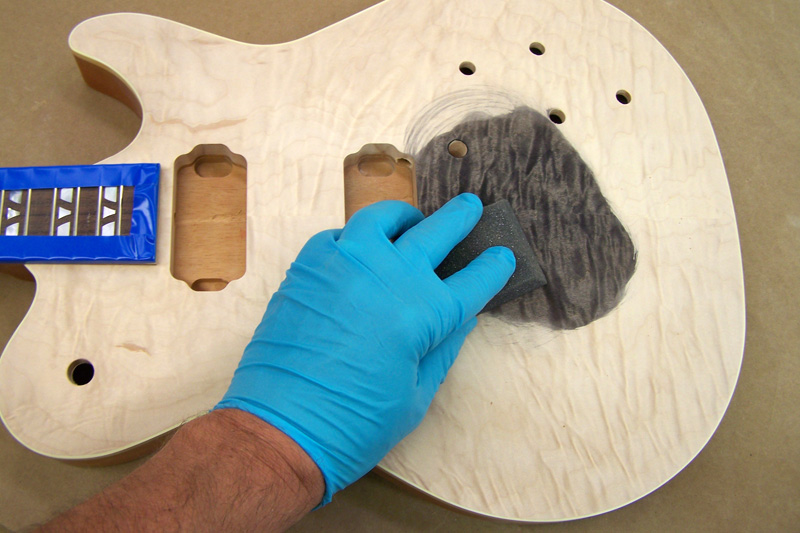 After the neck and body have been bonded together, it's time to give James Valentine that black guitar that he wanted.  The back, sides and neck will be opaque black while the top will be black transparent. This way James will get a black guitar but with the same sound that he liked so much from the Amberburst guitar that he first played. 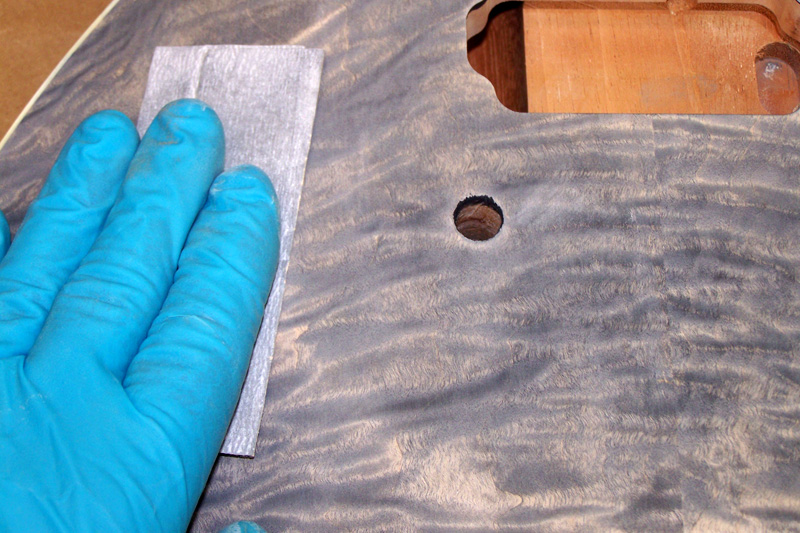 After the first coat of stain is applied, we sand it down. 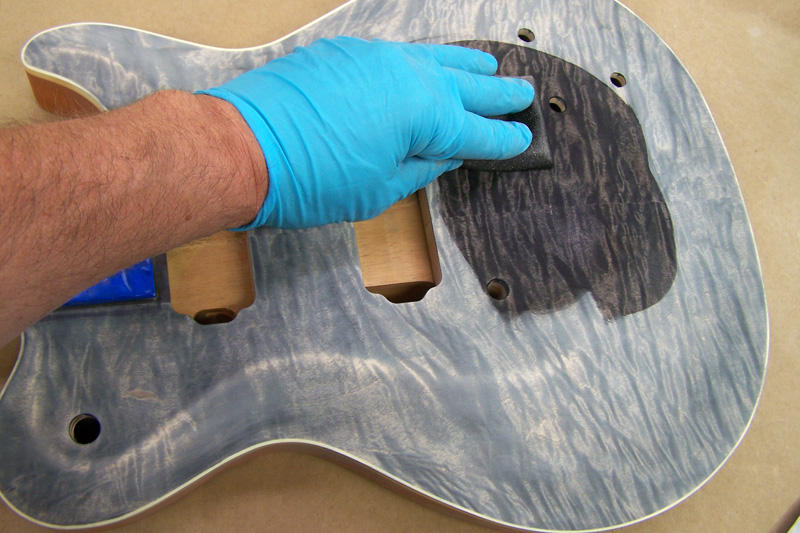 Only to apply a second coat of stain. Much of the finishing processes at Hamer are quite traditional. We apply many thin coats of finish and repeatedly sand it down flat. This is how luthiers have been applying finishes from the onset. The top took the stain beautifully. 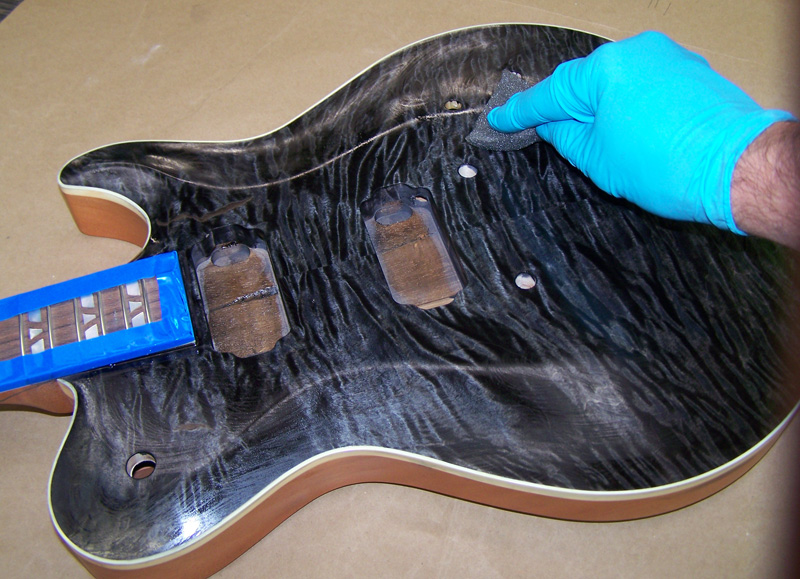
The guitar is ready for the spraybooth where Gary Pirro will perform his magic. 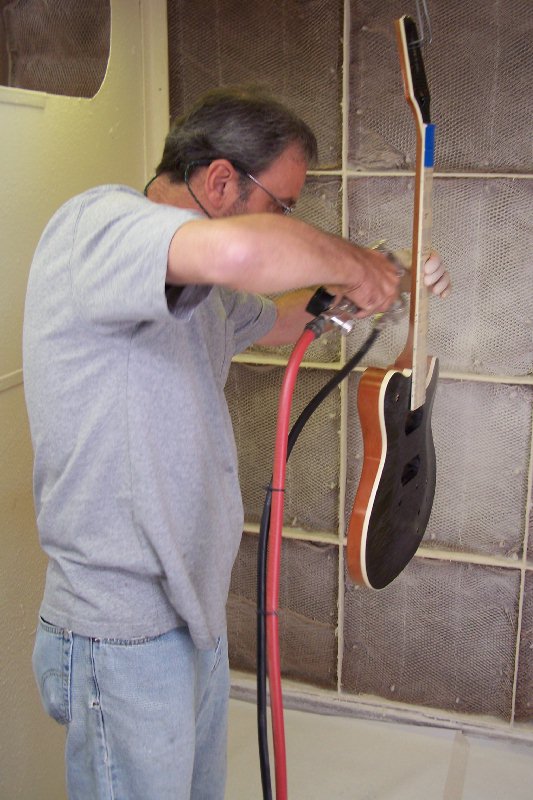 Free BirdPosted on September 15, 2010
| When we were approached to build an FB, we gave it some thought and decided...why not? In the past we had built this body style both for guitars and basses. The first FB was built in March, 1986. We actually built more basses than guitars, which may well have been due to our relationship with Nikki Sixx. We don't have the original tooling for the FB series so everything had to be laid out and routed by hand. Note the pencil lines extending from the neck rout. 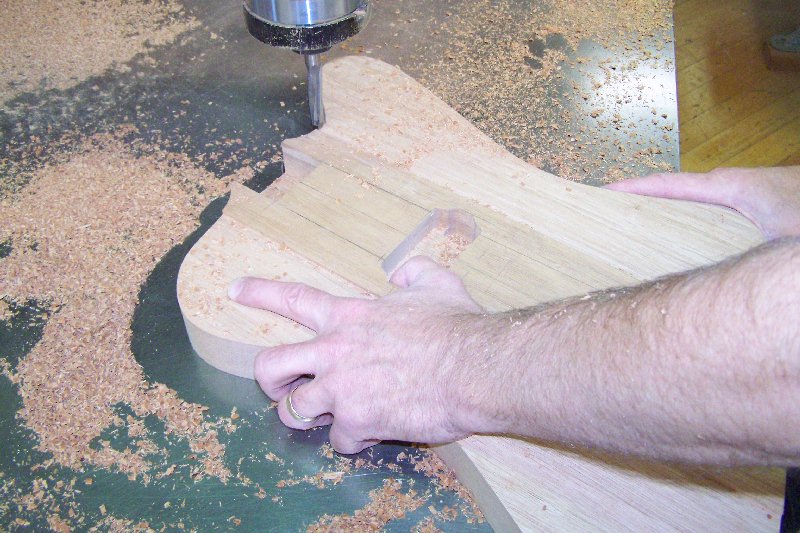 Rather than building the body from three pieces of wood as would be typical for a guitar like this, we built it from one massive piece of mahogany and then routed the wings down, leaving the raised center section. Final routing the body perimiter. 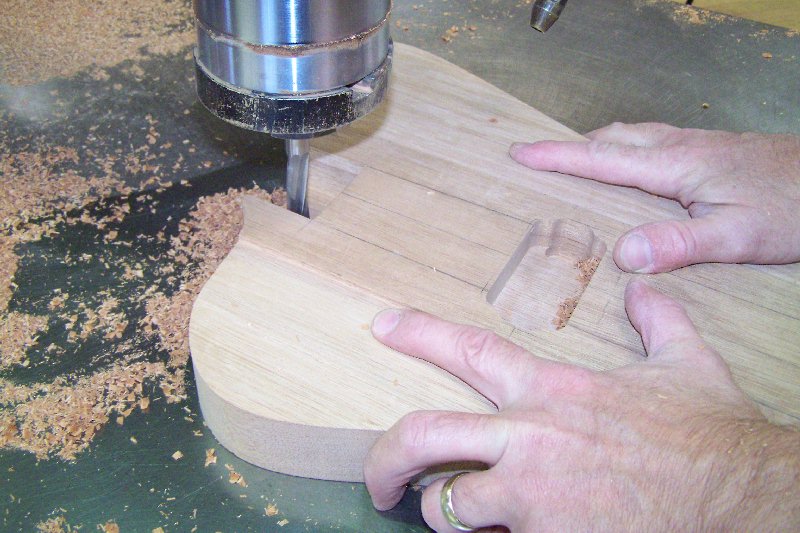 Here we are plunge routing for the pickup tabs and height adjustment screws. Typically, the guitars had two pickups. This order called for one humbucker, making the woodworking somewhat more complex. Because the neck continues for the length of the entire fingerboard and we retain a very tight neck joint we can build the guitar without a neck pickup. 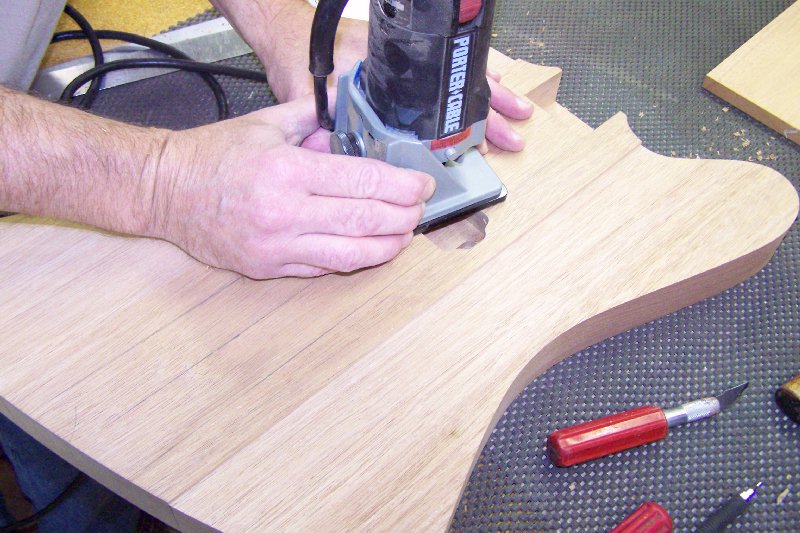  Did we mention that it was ordered with a reverse Standard headstock?  The neck has been bonded to the body and the guitar filled with grain filler.  Measuring and laying out for the bridge position.  Drilling for the bridge.  With a single pickup and one volume control, the electronics cavity is sparse.  Taped up and ready to for paint. What color will set this bird free... A Vintner's DreamPosted on September 22, 2010
| We were somewhat surprised when our long time friend Mark Snyder decided to come off the road and take up a day job. We first got to know Mark when he was Vernon Reid's guitar tech. He later worked with Peter Frampton, collaborating with him on the Framptone line of effects. Perhaps we shouldn't have been terribly surprised that Mark's day job was to start a winery in...Brooklyn! It's not as outlandish as it might sound. Mark supports local growers by using New York grapes. He was recently featured in his winery in Guitar Afficianado. Mark introduced us to Robert Foley. They're close friends and business associates. Earlier, in its maiden issue, Bob was featured in Guitar Afficianado. In addition to guitars, the magazine is clearly big on wine. Bob owns the prestigious Robert Foley vineyards in Napa Valley. His vineyard is the Hamer of wines: small, handcrafted and of the highest quality. When he's not making some of the best wines that come out of Napa, Bob is playing guitar. His placing an order for an Artist Ultimate seemed a natural. The color? Cognac of course. We previously showed you this Ultimate being built in our woodshop. Here are some pics of it coming to fruition.  The guitar is grounded to the Belgian shielding paint that is applied to the pickup cavities.  Using a set screw to lock the tailpiece into the stud. 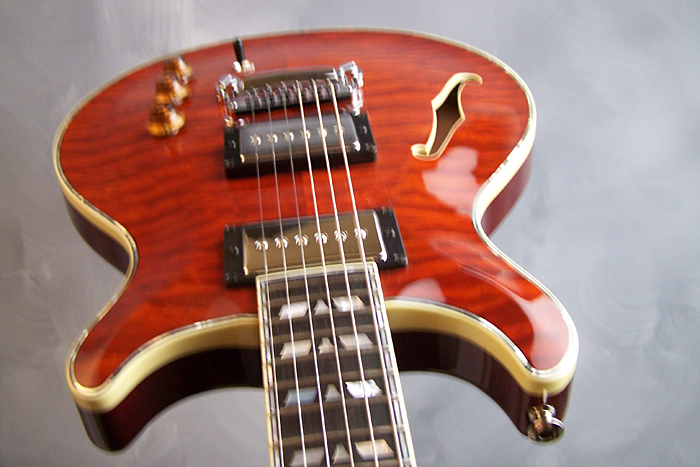 Normally we outfit Artist Ultimates with Duncan Custom Shop serialized and and signed humbuckers. This guitar was fitted with Phat Cat single coil pickups that we developed in conjunction with Seymour Duncan. 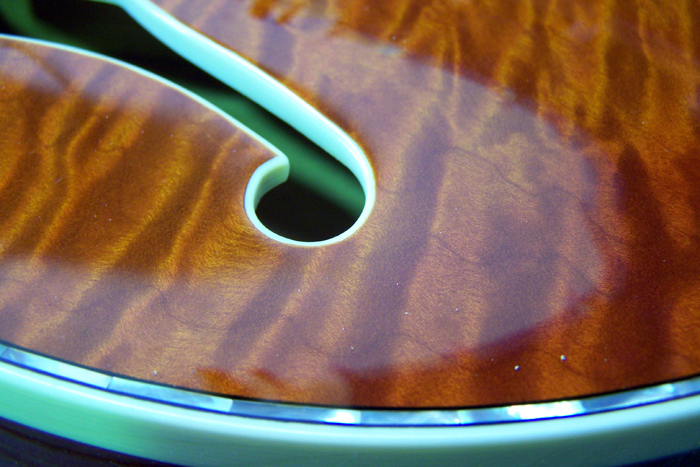 Nice detail work.  Measuring for string action.
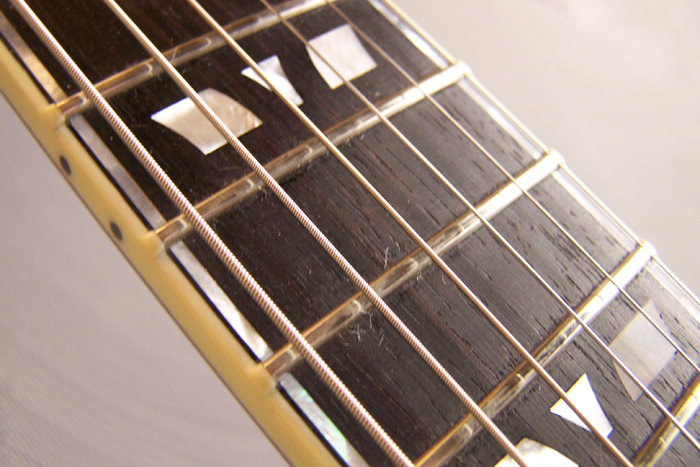 Hand cut mother mother of pearl purfling.  Dangerous curves. 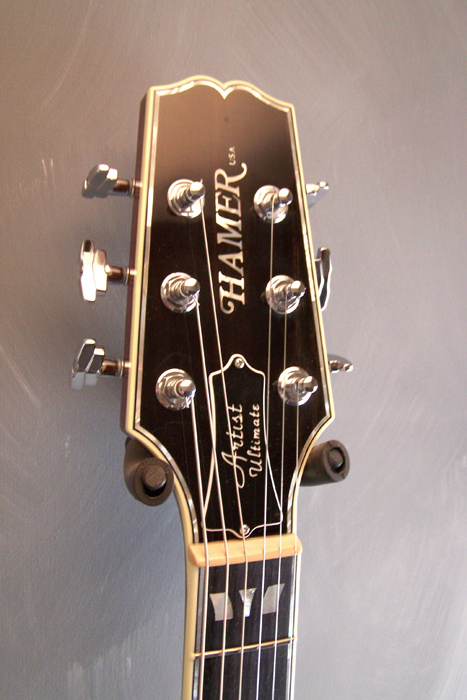 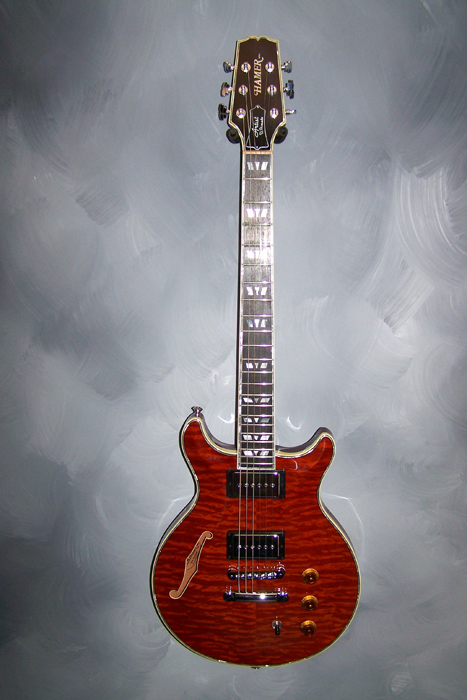 In addition to their normal serial number, Artist Ultimates are wood stamped with a consequtive serial number. This guitar is the 66th Artist Ultimate built - an excellent vintage. Previous Month
| Next Month
| | ||||||||||||||||||||||||||||||||||||||||||||||||||||||||||||||||||||||